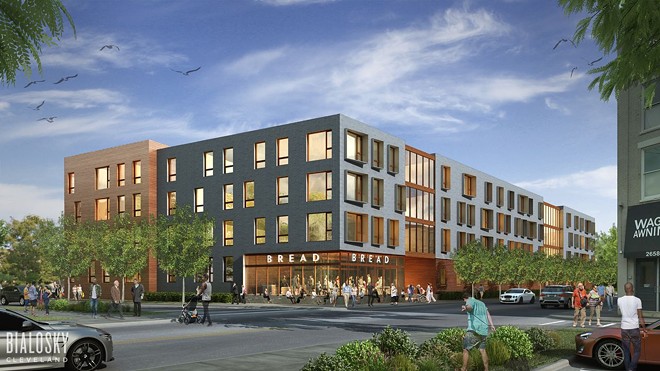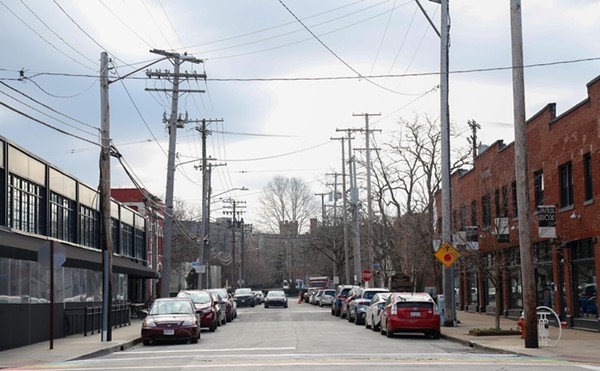Cleveland Has a Middle-Class Housing Affordability Problem
By Lee Chilcote on Thu, Jul 30, 2020 at 9:24 am
[
{
"name": "Ad - NativeInline - Injected",
"component": "38482495",
"insertPoint": "3",
"requiredCountToDisplay": "5"
},{
"name": "Real 1 Player (r2) - Inline",
"component": "38482494",
"insertPoint": "2/3",
"requiredCountToDisplay": "9"
}
]
Anya Hodgson has a problem. Although the realtor with Berkshire Hathaway HomeServices says that about a third of her business is selling to professional workers who want to live in the city, her buyers are increasingly getting shut out of neighborhoods where they want to be, such as Tremont, Ohio City and University Circle, because they can’t afford to live there.
Home prices in Cleveland have risen in the past five years, jumping 16 percent in the last year alone, from an average of $39,900 in January 2019 to $47,500 in January 2020, according to the regional multiple listing service YES MLS. In May, they took another jump up to $51,750. Supply of for-sale housing, especially on the lower end, has not kept pace with demand, especially from millennials entering the market with a rapacious appetite for home ownership after years of renting through bad economic times.
With sellers reluctant to put their homes on the market during the Covid-19 pandemic, a supply shortage has driven up prices. Basically, there are fewer homes selling, but the ones that are selling are getting a higher price and moving at a faster clip. Many experts say that the housing bubble likely won't burst anytime soon, because it's driven by low interest rates and pent-up demand from younger homebuyers.
For the last few years, it’s been tough to find a move-in-ready home under $300,000 in Ohio City and Tremont, Hodgson says, and with the new units being built priced well above that high-water mark, first-time buyers are often forced to choose between paying higher prices and looking at other neighborhoods that are less desirable to them, including the suburbs.
“I’m finding that I have these totally qualified candidates, who want to live in the city of Cleveland and contribute, who have good credit and decent income, but who can’t find houses they can afford,” she says. “Everything they find in the $200-300,000 range needs too much work, and all of the new homes that are being built are over $500,000 and they’re being priced out. They’re teachers, they’re social workers. In every other way, they’re qualified and should be able to find a home.”
Now, during Covid-19, there are still serious buyers looking, but there are fewer homes to choose from and the ones that are in move-in condition and priced right often sell immediately, after receiving multiple offers. “I’ve been in multiple situations, in recent weeks, where my client has been the fifth or sixth offer on a house,” Hodgson says. “They’re flying off the shelves.”
The impact on future housing affordability is unclear, but prices aren’t going down yet. “If anything, people bump up what they’re asking because they know they’re the only ones on the market.”
To meet demand over the past few years, developers have begun creating more middle-income for-sale housing in neighborhoods like Clark-Fulton, Glenville and Fairfax that are adjacent to higher-priced areas and where land is cheaper or can be obtained through the city land bank. These are also areas where the mayor’s Neighborhood Transformation Initiative (NTI) is investing up to $25 million in housing and economic development projects.
Bo Knez of Knez Homes got started in the city by building a million-dollar custom home in Tremont, but these days his team is building single-family homes and townhomes in Glenville in the $200,000’s. He’s sold 15-20 of them in the past two years. The area’s proximity to the “eds and meds” of University Circle and the Cleveland Clinic is key to his success, he says.
He’s also building 30 affordable lease-purchase homes for the Famicos Foundation. The total market value of his investments in the area will be north of $50 million when he is done, he says. Covid-19 has not slowed things down so far, he adds. Knez anticipates selling at least four houses this week in various parts of the city, and hopes to break ground later this year on a new townhouse project in Glenville and single-family houses in Fairfax, among other projects.
“Everything we have there currently is sold,” says Knez, who has lots available and is now working on three additional townhouse projects. “In University Circle, you can buy things for half a million to $700,000, but the units we’re currently building are at a lower price point.”
Pent-Up Demand
Cleveland’s housing shortage has its roots in the 2008-2009 housing crisis when an entire generation of millennials came of age in a bottomed-out economy as renters instead of owners. Soon neighborhoods like Ohio City, Tremont, downtown and University Circle became hot rental markets. As the economy got better, it unleashed a wave of pent-up demand from renters looking to walk to brunch in Hingetown or have a two-minute commute to their downtown jobs.
Despite a building frenzy, demand quickly outstripped supply in these hot areas, and by the mid 2010’s prices were climbing. In a January 10th article on Cleveland’s preternaturally hot market, Cleveland.com’s Rich Exner wrote: “If you want in on a typical home sale in Cleveland’s Tremont neighborhood, be ready to spend a quarter-million dollars.” Compare that to an average of $174,950 in 2016 – more than a 25 percent bump in three years. To the north, prices in Ohio City have risen from $124,000 in 2017 to $156,250 in 2019, while in Detroit Shoreway, once the more affordable alternative to Ohio City, prices have jumped from $61,250 in 2017 to $169,250 in 2019. University Circle’s too-hot-to-touch average home prices were $345,800 in 2019.
While the average sale price in Cuyahoga County increased from $125,000 to $136,750 from January 2019 to January 2020, then jumped up to $147,000 in May, Northeast Ohio is still affordable relative to the rest of the country. The median U.S. sale price was $274,500 in January 2020, up nearly eight percent from a year ago. Even relative to our diminished earnings - households in Cuyahoga County have a median annual income of $49,910, less than the median US income of $61,937 – a home in Cleveland is still less expensive than in other cities.
Yet the 2020 National Housing Forecast from Realtor.com says the affordability problem will get worse for first-time homebuyers, not better. An estimated 8.3 to 9.2 million first-time homebuyers are expected to hit the market in the next few years, that study says. Even before the coronavirus hit, people were already tending to stay put longer in their homes, especially baby boomers, and now the Covid-19 pandemic has made it worse by adding more uncertainty.
Consultant Gina Kelly and her husband rented for years in Ohio City, but they ended up buying a three-bedroom house in Shaker Heights because they couldn’t find a home that they liked at a price point they could afford in the neighborhood. “We kept looking for something that was right, and then 2015 hit, and the houses that used to be affordable were half a million dollars,” she says.
Hodgson says this story is not uncommon. “They end up purchasing in Old Brooklyn, Collinwood, or some in the Heights,” she says of many first-time buyers.
However, Natalie Hatchet, a 57-year-old sales representative who moved from Strongsville, found what she was looking for in Glenville. Hatchet, who is Italian-American, says she wanted to be close to restaurants, shops and galleries in Little Italy and University Circle but couldn’t afford to buy there. She bought her home because of the 15-year tax abatement, the opportunity to custom build, and because it’s a good investment.
Friends who questioned her decision changed their mind after visiting and seeing how nice the area is. “They thought I was crazy,” she says. “Every one of them has apologized to me.”
Councilman Kevin Conwell, who represents Glenville, University Circle and Little Italy, says it’s important to make sure that developing is inclusive and benefits current residents. He touts the fact that in Glenville, the city of Cleveland and the Finch Group recently partnered on the $15 million, 63-unit Glenville Circle North building. Rents for a one-bedroom unit start at over $1,000 per month, but 20 percent of the units are set aside as affordable housing. It also has seven first floor retail spaces, including Black Box Fix and a neighborhood barbershop.
“Here’s the risk – if you make everything high-end, then you’re going to push people out to the suburbs, because they can’t find something nice that they can afford,” says Conwell. “We need affordable housing, and that will also help us fight against gentrification. Many of the apartments being built in Cleveland are going for $1,500 per month – single mothers can’t afford that.”
John Anoliefo, director of the nonprofit Famicos Foundation, says Knez’s investment is a huge positive for the area but must be accompanied by more affordable housing and home rehabs in order to provide a balanced approach. Famicos rehabs older homes in the neighborhood using city subsidy, because the private market isn’t yet able to make a profit on these projects.
Although the coronavirus and the impending economic depression may slow things down, more development will come because of the investment from Knez, the Finch Group, the city and others, he says. “You’re going to see other investors and developers coming in and buying vacant land, now that they know they can get their money by making that investment.”
Although this may change if there’s a prolonged economic recession, Knez’s biggest problem is getting permits out of the city. During the pandemic, the building department has only been open two days a week and inspectors have been slow to set up appointments. “We have sold units where we need to get in the ground, but there’s an extended timeline. Everything’s slower.”
Rising Rents
The cost of renting an apartment in Cleveland has also jumped dramatically in recent years. According to Zumper’s national rent index, last year Cleveland ranked number one in year-over-year growth for one-bedroom rental units, which rose 16 percent to $940 per month on average (the national median is $1,230). Meanwhile, two-bedroom units jumped 14.9 percent to $1,000 per month on average. In 2019, Cleveland jumped 17 spots from 74 to 57 on the index.
Some of the new units coming online in Ohio City and University Circle are priced at over $2 per square foot, putting them effectively out of reach for many people. An 819 square foot one-bedroom unit at the Nine downtown rents for $1,765, meaning that if rent should be no more than 33 percent of a person’s income, you’d have to make $75,000 to be able to afford it. Although some apartment owners are offering concessions – a recent Crain’s article reported that the Beacon is offering six months of free rent, which is worth as much as $10,000 – that may not be enough for many renters.
To bridge the gap, some developers are trying to build workforce housing that is affordable to households earning between 60 and 120 percent of area median income (AMI). In cities across the country where it’s difficult for middle-income workers to buy or rent where they work, experts recommend repurposing vacant land, adopting inclusionary zoning (requiring a percentage of units in a development to be affordable), updating land development codes to encourage development in urban areas, and allowing single-family owners to build and rent out accessory dwelling units, among other things.
One workforce housing project in Cleveland is the Tappan in Tremont, where developer Sustainable Community Associates (SCA) plans to set aside 60 percent of the residential units there for people whose annual income is $48,300 or less. Monthly rent for the mix of studio or one-bedroom units is between $1,150 and $1,300; the other 40 percent of apartments is market rate. SCA built the Tappan partially by using Opportunity Zone funding, which incentivizes investment in economically-distressed areas by allowing investors to delay or avoid paying capital gains taxes if they invest within certain Census tracts designated Opportunity Zones.
"It was built with way more then OZ funding," SCA told Scene. "We also had traditional lending."
On Barber Avenue in Clark-Fulton, first-time developer Ben Beckman is also developing workforce housing in the old J. Spang Bakery. Before he bought the property and turned it into the BVQ Lofts (it stands for Barber-Vega-Queen, the cross streets), parts of it were falling down and there were numerous health and safety violations. Through an $18 million project, he’s transformed this eyesore into 69 rental apartments.
Beckman’s project, which is literally just over the RTA tracks from Ohio City and Tremont, redevelops a neglected part of the city. During a pre-pandemic tour, he points out details like the exposed J&L Steel ceiling beams from the old mill where the Steelyard Home Depot now stands (“I had fun saying to my dad, ‘Hey, here’s some steel from J&L,’ since he pushed a broom there for 12 years,” Beckman says); the ancient cooler doors that are now a cool apartment feature; and the custom-built monitor skylights that they added to bring in more natural light.
As he steps into a unit with 14-foot ceilings, a brand-new granite kitchen, and cleaned-up original tile on the floor and walls, Beckman smiles at the history. “This is the old production floor, this is where they did the baking of the bread. You’ve got 1920s clean room technology here, a glazed brick floor and terra cotta walls. This floor tile is something they patented; it has safety grip and washes down easily. We’re going to put the patent number out in the lobby.”
“Every unit tells its own story,” he says.
Beckman hopes to entice renters to move to Clark-Fulton by pricing the units at about $1.50 per square foot, substantially cheaper than similar units a mile or two north. Apartments here range from 500 to 1,400 square feet, and are priced from $745 per month for the smallest single to $1,800 for the largest triple. They feature in-suite laundry, generous parking, and high-speed Internet. Most of the units are open and don’t have bedrooms or closets – they’re true lofts.
Right now, he doesn’t believe the coronavirus has significantly dampened demand, and in fact the suites may be attractive in a work-from-home era. His tenants appreciate the unique handcrafted style as well as the building’s affordability. “If you like it, you’re going to spend 40 percent less than at 25th and Detroit,” he says, noting that it’s more than 50 percent leased and he gets 2-3 inquiries every day. “If not, then this may not be for you. It’s not for everybody.”
It was definitely for John Kurek, a 30-year-old nurse who works nights at the ICU stepdown unit at University Hospitals in Parma. He rented one of the larger one-bedrooms for $1,275, and rents two parking spaces for his motorcycle and two cars (he’s a car guy). As a single guy, Kurek enjoys being close to nightlife and work. “For the same amount of money, you’d get a whole lot less living downtown,” he says.
Ricardo Leon, executive director of Metro West CDC, hails BVQ Lofts as one of the first market-rate developments in Clark-Fulton to be built in many years. It could also offer a move-up opportunity for existing neighborhood residents. “This is a big deal for us, kind of like a proof of concept, that you can take a property and rehab it, leveraging historic tax credits, and bring it to market at what is the top end of our market, but still cheaper than any other neighborhood around us,” he says, adding, “I think it’s going to catalyze development around it.”
Tom Bier, a retired professor at the Levin College of Urban Affairs at Cleveland State University, believes that the city’s investment in Clark-Fulton and Glenville could kickstart these neighborhoods in the same way it did in Ohio City more than 20 years ago. “The question is, if we provide incentives for development where it’s not happening, might it catch on and get rolling?” he says. “When the city redid West 25th Street, to me that was the breakout point for Ohio City. The city made that investment, and boy did that pay off.”
SCENE Supporters make it possible to tell the Cleveland stories you won’t find elsewhere.
Become a supporter today.
Scroll to read more Cleveland News articles
Newsletters
Join Cleveland Scene Newsletters
Subscribe now to get the latest news delivered right to your inbox.














